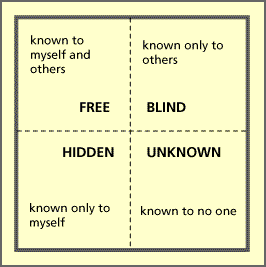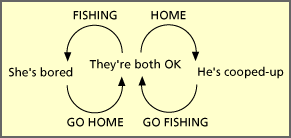 is known to him- or her-self
and to others.
is known to him- or her-self
and to others.

 TUTORIAL: INTERACTION AND RELATIONSHIPS
TUTORIAL: INTERACTION AND RELATIONSHIPSINTRODUCTION . NON-VERBAL COMMUNICATION . KINESICS . DISTANCE AND ARRANGEMENT . SPEECH ACTS . RELATIONSHIPS . KNOWING OTHERS . SELF-DISCLOSURE . PUNCTUATION . COORDINATED MANAGEMENT OF MEANING .
As the participants in a relationship come to know one another more completely, the quality of their relationship tends to deepen. An area of communication study that has to do with how this comes about is called self-disclosure. Self-disclosure describes the ways in which humans provide others with information about themselves.
One simple, clear model of self disclosure was developed by
Joseph Luft and Harrington Ingram in 1969. The Johari Window, as it is
called, describes an individual in terms of what
 is known to him- or her-self
and to others.
is known to him- or her-self
and to others.
In the Johari Window model the Free Area represents characteristics of myself that have been shared with others -- in other words, things I know about myself that others know, too.
The Hidden Area represents characteristics of myself that haven't been shared with others.
The Blind Area represents public characteristics of myself that are not self-knowledge, that is, I don't know about them, but others do.
The Unknown Area represents characteristics of myself that are known to no one, including myself.
Consider some examples:
Taken together, Speech Act Theory, the Miller-Steinberg Model and the Johari Window provide us with many interesting insights into the interactive, engaging nature of human communication. For example, consider a situation in which the speaker performs a perlocutionary act (in an attempt to influence the behavior of the receiver). In doing so the speaker may be basing his or her choice of message on assumptions that are false because they are contained in the receivers Hidden Area. In that case the receiver may be unsure as to how to interpret the message and may respond with a different action than the speaker expects.
On the other hand, the receiver may possess information from the addresser's
Blind Area, and may respond in a way that seems arbitrary or mysterious to the
speaker but which in reality is based on the self-characteristics that the
speaker doesn't know about. Each of these situations may unfold differently
depending on the level of communication rules and the level of knowledge in use
by the participants.
![]() 4014
4014
![]() 4017.
4017.
![]() 4018
4018
For example, in a previous example we spoke of Margie who, when she plays poker with her friends, has a habit of smiling whenever she is "bluffing." This information is in Margie's Blind Area which means that she doesn't realize it, although some of her friends do.
Suppose that Margie makes a fairly large bet on a relatively poor holding of cards, hoping to "fake out" or "bluff" the other players into dropping out. By this perlocutionary speech act she intends to influence the others' behavior. But some of the others see her smile and, recognizing that she is bluffing, refuse to act as she wishes them to. To Margie this response is at first puzzling, but if it continues for a period of time, she may notice the pattern and eventually deduce that she is giving away her plans. At this point, she may decline to self-disclose and use her new self-knowledge to "fake" a bluff when in fact she has a good hand. Of course, if she succeeds at this, she will then have disclosed this new knowledge (albeit indirectly) to her friends.
Self-disclosure informs one participant in a relationship about the other and thus makes both more knowledgeable of the context of their relationship. Thus, self-disclosure can lead to the development of personal rules and to closer and more tightly focused relationships.
The next section shows how misunderstanding can arise even when both participants are satisfied with their knowledge of one another.
A group of theorists known as the "Palo Alto Group," who are represented here by the theories of Paul Watzlawick, shift the focus of communication in relationships from the intentions of the individual participants to their mutual interaction within a communication system.
Watzlawick's model of interactive communication separates the content of the communication (or what is said) from the form of the communication (or how it is said). In illustration of this, consider Watzlawick's theory of punctuation.
Relationships become stronger as the participants become increasingly able to predict one another's behavior. Punctuation describes the way that communicators anticipate the outcomes of communication events as they organize the reality of their day-to-day lives. In particular, punctuation occurs when one of the participants changes his or her behavior based on an anticipation of what the other will say before he or she actually says it.
As an example of this, consider the situation in which a student receives from a professor an assignment to write a paper. The student may punctuate this assignment by anticipating that the professor expects the paper to be a certain length, or to be written in a certain style, and so may set out to write what the student thinks the professor "wants." The product of this process will be different than what would have been produced if the student had not taken the professor's preferences into account.
Because punctuation is an act that involves one communicator's interpretation of another's expectations, its effects tend to produce ambiguity. In this case, for example, it might be argued that the student's creativity has been restricted by this punctuation. But it also might be argued that the punctuation gives guidance to a student who is learning how to write.
As the participants in a relationship punctuate their ongoing communication, patterns of recurring behavior can arise. For example, consider the relationship of Tania and Gerald, two people who truly enjoy one other's company. Tania likes to "sit and chat" and enjoys "fixing up" and doing odd jobs around the house. Gerald likes to "fish" and enjoys the relaxed atmosphere of being out on the water.
After a few weeks inside the house, Gerald begins to feel "cooped up," on-the-other-hand, sitting in a fishing boat all day leaves Tania feeling restless and "bored."
At first, at home, they both feel good. But as Tania keeps talking and finding new household fix-it jobs for Gerald to do, he begins to feel cooped-up. Tania anticipates his unhappiness and so she suggests that they go fishing. At first, on the boat, they both feel good. But as Gerald relaxes and withdraws into his own thoughts, Tania begins to feel bored. Gerald anticipates her unhappiness and so he suggests that they go home.

Even though the participants encounter the same data in the
course of their communication, each derives different information. Tania
punctuates the communication with regard to Gerald's feeling "cooped-up," and
Gerald punctuates it in terms of Tania feeling "bored." The result of this is
that they establish a pattern of behavior that neither of them fully
comprehends. In fact each of them would probably say that the other is
"causing" them to cut their favorite activity short.
![]() 4003
4003
![]() 4006
4006
![]() 4019
4019
As with each of the theories and models presented in this tutorial, there is much more to be said of the work of Watzlawick and the Palo Alto Group, but the point of emphasize here is their notion that a relationship is a system in which the individual participants are only partly responsible for what happens, and that the full behavior of the system includes effects that arise only as the two participants interact.